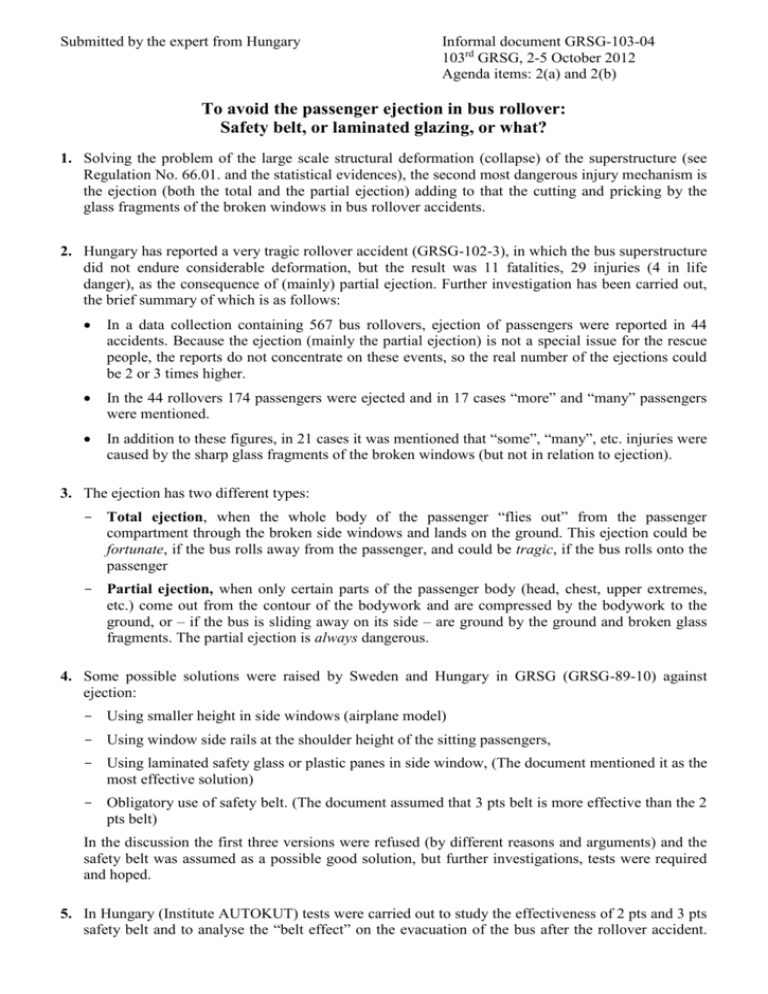Submitted by Hungary
advertisement

Submitted by the expert from Hungary Informal document GRSG-103-04 103rd GRSG, 2-5 October 2012 Agenda items: 2(a) and 2(b) To avoid the passenger ejection in bus rollover: Safety belt, or laminated glazing, or what? 1. Solving the problem of the large scale structural deformation (collapse) of the superstructure (see Regulation No. 66.01. and the statistical evidences), the second most dangerous injury mechanism is the ejection (both the total and the partial ejection) adding to that the cutting and pricking by the glass fragments of the broken windows in bus rollover accidents. 2. Hungary has reported a very tragic rollover accident (GRSG-102-3), in which the bus superstructure did not endure considerable deformation, but the result was 11 fatalities, 29 injuries (4 in life danger), as the consequence of (mainly) partial ejection. Further investigation has been carried out, the brief summary of which is as follows: In a data collection containing 567 bus rollovers, ejection of passengers were reported in 44 accidents. Because the ejection (mainly the partial ejection) is not a special issue for the rescue people, the reports do not concentrate on these events, so the real number of the ejections could be 2 or 3 times higher. In the 44 rollovers 174 passengers were ejected and in 17 cases “more” and “many” passengers were mentioned. In addition to these figures, in 21 cases it was mentioned that “some”, “many”, etc. injuries were caused by the sharp glass fragments of the broken windows (but not in relation to ejection). 3. The ejection has two different types: - Total ejection, when the whole body of the passenger “flies out” from the passenger compartment through the broken side windows and lands on the ground. This ejection could be fortunate, if the bus rolls away from the passenger, and could be tragic, if the bus rolls onto the passenger - Partial ejection, when only certain parts of the passenger body (head, chest, upper extremes, etc.) come out from the contour of the bodywork and are compressed by the bodywork to the ground, or – if the bus is sliding away on its side – are ground by the ground and broken glass fragments. The partial ejection is always dangerous. 4. Some possible solutions were raised by Sweden and Hungary in GRSG (GRSG-89-10) against ejection: - Using smaller height in side windows (airplane model) - Using window side rails at the shoulder height of the sitting passengers, - Using laminated safety glass or plastic panes in side window, (The document mentioned it as the most effective solution) - Obligatory use of safety belt. (The document assumed that 3 pts belt is more effective than the 2 pts belt) In the discussion the first three versions were refused (by different reasons and arguments) and the safety belt was assumed as a possible good solution, but further investigations, tests were required and hoped. 5. In Hungary (Institute AUTOKUT) tests were carried out to study the effectiveness of 2 pts and 3 pts safety belt and to analyse the “belt effect” on the evacuation of the bus after the rollover accident. 50% Hybrid III (male) dummy and real human body were used in the test. (The tests will be shown in a Power Point presentation). The main conclusions of the tests and the further study: both 3 pts and 2 pts belt can avoid the total ejection. neither 3 pts nor 2 pts belt can avoid the partial ejection the Hybrid III. Dummy does not represent the real human body behaviour and motion in rollover. These dummies shall not be used in rollover tests or rollover simulation, they are very “rigid” in crosswise direction. when the bus is lying on its side and the passengers are belted, in this position they are hanging on the seat belt. In this situation the safety belt cannot be released by finger pressure, because of the very high releasing force (310-380 N) the hanging passengers can not evacuate the bus. If a fire follows the rollover, there is only a short time (250- 300 s) to leave the bus, because the rapidly increasing temperature, smoke density and poisonous gases do not give more time. The main conclusion of these tests is that the safety belt may have more disadvantages than advantages in rollover, and it is ineffective solution against partial ejection. 6. The main injury mechanisms in bus accidents: a) Compression: it may be said that is solved by the required strength of the superstructure in rollover accident b) Ejection: (both total and partial), the second most severe injury, it should be solved as the next step. c) Cut and prick by glass fragments d) Projection (inside motion of the passengers, bumping each others and/or structural parts) e) Burning by fire There is no one technical solution or tool which is effective against all of these injury mechanisms. Wide range general study and analysis is needed to protect the bus occupants against all of these injuries, considering the major types of bus accidents and past accident positions, all possible passenger locations in the bus and the evacuation possibilities. 7. The use of laminated glassing in side windows seems to be a good tool, a good solution against “b” and “c”. To introduce the laminated safety glass in side windows of buses could be done by a step by step approach: - To exclude the breakable emergency windows from among the required number of exits on buses (this proposal is already made by Hungary to GRSG). - To delete paragraph 7.6.8.2.2. from R.107, Annex 3. which “provision precludes the possibility of using panes of laminated glass or of plastic material.” (It could be easily done, but before deleting this paragraph, it should be carefully analysed any kind of direct or indirect relation to the other paragraphs, provisions. Consolidated proposal is needed). In other words, this step would allow the use of laminated glassing or plastic panes, in side windows. - When the informal group of GRSG finishes its work about the plastic glassing (R.43), in the light of the group’s proposal GRSG could start to think about the exclusion of tempered glass from the bus application and require laminated glazing or plastic panes. - General study, research should be initiated on international level to find good solution(s) against all major injury mechanisms as mentioned in paragraph 6. and to find out the possible advantages and disadvantages of the safety belt in buses. 2







